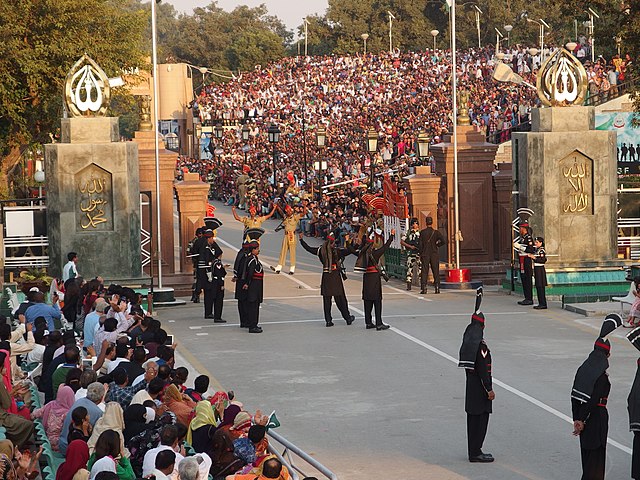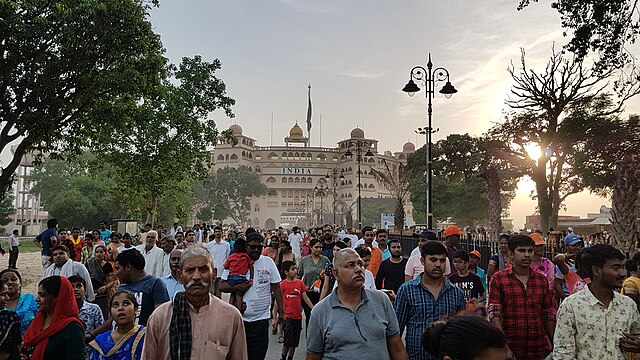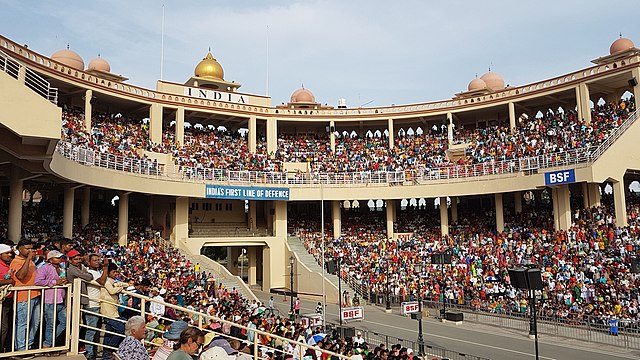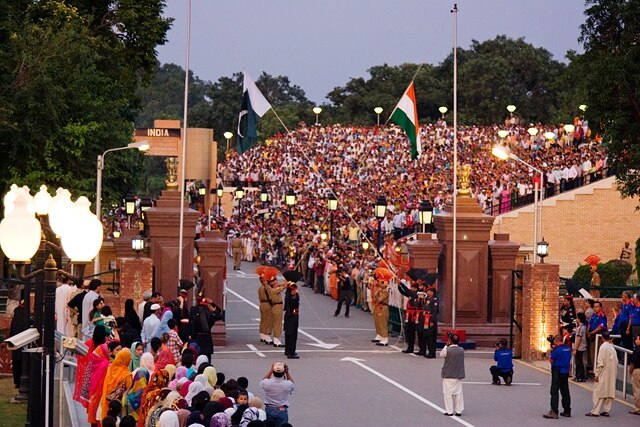Have you ever wondered what it’s like to witness one of the world’s most dramatic border ceremonies? Welcome to Wagah Border, where patriotism meets pageantry in a daily spectacle that’s both inspiring and surreal. This isn’t just any ordinary border crossing – it’s a living theater where two nations showcase their pride, discipline, and complex relationship through an elaborate military ceremony that’s been captivating visitors for decades.
What is Wagah Border?
Wagah Border represents far more than just a line on a map. It’s the only road border crossing between India and Pakistan that’s open to civilians, making it a unique window into the relationship between these two neighboring nations. Located on the Grand Trunk Road, this border post serves as both a practical crossing point and a powerful symbol of the partition that divided the Indian subcontinent in 1947.
Location and Geography
Situated approximately 32 kilometers from Amritsar in Punjab, India, and about 24 kilometers from Lahore in Pakistan, Wagah sits strategically on one of the most historically significant roads in South Asia. The Grand Trunk Road, which runs through Wagah, has been a crucial trade and travel route for centuries, connecting Central Asia to the Indian subcontinent.
The border post itself is characterized by its distinctive gates, watchtowers, and the famous parade ground where the daily ceremony takes place. The infrastructure reflects the serious nature of border security while accommodating thousands of daily visitors who come to witness the ceremony.
Historical Significance
The significance of Wagah extends beyond its current role as a tourist attraction. This border represents the physical manifestation of one of history’s largest mass migrations. When India and Pakistan were partitioned in 1947, millions of people crossed through points like Wagah, carrying their hopes, fears, and entire lives in whatever they could manage.
Today, Wagah stands as a reminder of both division and unity – division in the sense that it separates two nations, and unity in the shared cultural heritage that both sides continue to celebrate through the daily ceremony.
The Famous Wagah Border Ceremony

What makes Wagah Border truly special isn’t just its historical importance – it’s the incredible daily ceremony that transforms this border crossing into one of the most unique tourist experiences in the world. Every evening, thousands of people gather on both sides to witness what can only be described as a masterpiece of military choreography mixed with theatrical drama.
What Happens During the Ceremony?
The ceremony is a carefully orchestrated display of military precision and national pride. Soldiers from both the Indian Border Security Force (BSF) and Pakistan Rangers participate in a synchronized routine that’s both competitive and cooperative. The ceremony includes high-kicking marches, aggressive posturing, and synchronized movements that showcase the military prowess of both nations.
The atmosphere is electric as crowds from both sides cheer for their respective countries. The soldiers, dressed in elaborate uniforms with distinctive headgear, perform intricate drills that require months of practice to perfect. The ceremony culminates with the lowering of both national flags in perfect synchronization, followed by a brief handshake between the commanding officers – a moment that symbolizes the underlying respect between the two forces despite political tensions.
Timing and Schedule
The ceremony timing varies depending on the season to ensure it takes place before sunset. During summer months (April to September), the ceremony typically begins around 5:15 PM, while in winter months (October to March), it starts around 4:15 PM. The entire ceremony lasts approximately 45 minutes, but visitors are advised to arrive at least an hour early to secure good seating and experience the pre-ceremony atmosphere.
It’s worth noting that the ceremony takes place daily except during extreme weather conditions or special security situations. The consistency of this daily ritual has made it a reliable attraction for both domestic and international tourists.
The Beating Retreat Ceremony
The technical name for this daily spectacle is the “Beating Retreat” ceremony, a military tradition that dates back centuries. Originally, the beating retreat was a drumbeat signal used to tell soldiers to return to their quarters at the end of the day. At Wagah, this tradition has evolved into something much more elaborate and symbolic.
The ceremony serves multiple purposes: it’s a display of military discipline, a demonstration of national pride, and surprisingly, a form of diplomatic communication between two countries that often have strained relations. The precise coordination required between both sides makes it a unique example of cooperation amid competition.
History of Wagah Border
Understanding the history of Wagah Border requires delving into one of the most significant events of the 20th century – the partition of India. This border didn’t exist before 1947, and its creation changed the lives of millions of people forever.
Partition of 1947
When British India was divided into two independent nations – India and Pakistan – the Radcliffe Line became the new international border. Wagah found itself right on this line, transforming overnight from an ordinary village into a crucial border crossing. The partition led to one of the largest mass migrations in human history, with an estimated 14 million people crossing borders to reach their chosen homeland.
The early years of Wagah Border were marked by tragedy and hope in equal measure. Refugee camps were established on both sides, and the border post became a symbol of both separation and new beginnings. Families were divided, but new nations were born, and Wagah witnessed it all.
Evolution Over the Decades
The famous ceremony didn’t begin immediately after partition. In fact, the elaborate ritual we see today evolved gradually over several decades. The ceremony started as a simple flag-lowering routine but grew more elaborate as it became a tourist attraction. The competitive element developed naturally as both sides tried to outdo each other in displays of military precision and patriotic fervor.
Over the years, Wagah has witnessed various phases of India-Pakistan relations. During times of heightened tension, the ceremony has been suspended temporarily, but it has always resumed, demonstrating the enduring nature of this unique tradition. The ceremony has become so integral to the identity of Wagah that it’s hard to imagine the border without it.
Visiting Wagah Border: A Complete Tourist Guide
Planning a visit to Wagah Border requires some preparation, but the experience is absolutely worth the effort. Whether you’re a history enthusiast, a culture lover, or simply someone seeking a unique experience, Wagah offers something truly special.
How to Reach Wagah Border
From Amritsar
Most visitors reach Wagah Border via Amritsar, which is well-connected by air, rail, and road to major Indian cities. From Amritsar, Wagah is about a 45-minute drive under normal traffic conditions. The route is straightforward, following the Grand Trunk Road directly to the border.
Transportation Options
Several transportation options are available for reaching Wagah from Amritsar:
Private Taxis and Cars: This is the most convenient option, allowing you to travel at your own pace and timing. Many hotels in Amritsar can arrange taxi services specifically for Wagah Border visits.
Shared Taxis: More economical than private taxis, shared taxis are readily available from various points in Amritsar. These typically leave when full and operate on a fixed schedule.
Public Buses: Punjab Roadways operates regular bus services to Wagah Border. While this is the most economical option, it can be crowded, especially during peak tourist seasons.
Organized Tours: Many travel agencies offer half-day tours to Wagah Border, often combined with visits to other attractions in Amritsar like the Golden Temple.
Entry Requirements and Security

Security at Wagah Border is understandably strict. All visitors must carry valid photo identification, and the security process is similar to airport screening. Mobile phones, cameras, and bags are allowed, but they go through thorough security checks.
Foreign nationals need to carry their passports, while Indian citizens can use any government-issued photo ID. The security process can take 30-45 minutes during peak times, so plan accordingly. Prohibited items include weapons, sharp objects, and any items deemed security risks by the border authorities.
Best Time to Visit
While the ceremony happens daily throughout the year, certain times offer better experiences than others. The winter months (October to March) are generally more comfortable due to pleasant weather. However, this is also peak tourist season, so expect larger crowds.
Summer visits can be challenging due to the heat, but they offer the advantage of smaller crowds and easier parking. Monsoon season (July to September) can see occasional ceremony cancellations due to weather, but when it does happen, the post-rain atmosphere can be quite magical.
The Spectacle: What to Expect
Attending the Wagah Border ceremony is unlike any other tourist experience. It’s part sporting event, part military display, and part cultural celebration all rolled into one unforgettable package.
Crowd and Atmosphere
The atmosphere at Wagah is electric from the moment you arrive. Vendors sell flags, caps, and snacks while patriotic songs play over loudspeakers. The crowd itself becomes part of the show, with organized cheering, singing, and even dancing before the ceremony begins.
The Indian side typically accommodates around 15,000-20,000 spectators in stadium-style seating, while the Pakistani side has similar capacity. The energy is infectious, and even the most reserved visitors find themselves caught up in the patriotic fervor. Children wave flags, families sing along to patriotic songs, and the entire crowd becomes a sea of national colors.
Photography Guidelines
Photography is allowed and even encouraged at Wagah Border, but there are specific guidelines to follow. Professional cameras require special permission, while personal cameras and mobile phones are generally permitted. The best shots are typically captured during the ceremony itself, when the soldiers perform their elaborate routines against the backdrop of the gates and flags.
Visitors should be respectful when photographing and avoid using flash during the ceremony, as it can be distracting. The golden hour lighting during the ceremony provides excellent natural lighting for photography, making it perfect for capturing the drama and pageantry of the event.
Cultural Impact and Significance
Wagah Border represents much more than a tourist attraction – it’s a cultural phenomenon that reflects the complex relationship between India and Pakistan while celebrating shared heritage and traditions.
Symbol of Unity and Division
The paradox of Wagah lies in its dual nature as both a symbol of division and unity. While it represents the physical separation of two nations, the ceremony itself showcases the shared military traditions, cultural values, and even the competitive spirit that both countries inherited from their common past.
The ceremony has become a form of soft diplomacy, allowing both nations to display their strength and pride while maintaining a framework for peaceful interaction. Even during periods of political tension, the ceremony continues, serving as a reminder that despite differences, both sides share more similarities than differences.
Impact on Local Communities
The daily influx of thousands of tourists has transformed the local economy around Wagah Border. Small businesses, restaurants, souvenir shops, and transportation services have all benefited from the tourism boom. Local families often supplement their income by providing services to tourists, from parking to food.
However, this transformation has also brought challenges, including traffic congestion, environmental impact, and the need for better infrastructure. The local community has had to adapt to being at the center of one of India’s most popular tourist attractions.
Tips for First-Time Visitors
Making the most of your Wagah Border experience requires some insider knowledge and practical preparation.
What to Bring
Essential items for your visit include valid photo identification, comfortable clothing suitable for sitting outdoors, and sun protection during summer months. A water bottle is recommended, though refreshments are available for purchase at the venue.
Consider bringing a small cushion or seat pad, as the concrete benches can become uncomfortable during the lengthy ceremony. Indian flags or patriotic accessories can enhance your experience and help you blend in with the enthusiastic crowd.
Safety Considerations
While Wagah Border is generally safe for tourists, the large crowds and high-energy atmosphere require some precautions. Stay hydrated, especially during summer visits, and be prepared for the intense crowd dynamics. Parents should keep young children close, as the excitement can be overwhelming for them.
The security procedures are thorough but necessary, so arrive with patience and allow extra time for screening. Follow all instructions from security personnel and border guards, as this is an active international border with serious security protocols.
Beyond the Ceremony: Other Attractions

While the flag ceremony is the main attraction, the Wagah Border area offers several other points of interest that can enhance your visit.
Nearby Places to Visit
The journey to Wagah often includes stops at other significant locations. Many visitors combine their border visit with trips to Amritsar’s famous Golden Temple, Jallianwala Bagh memorial, and other historical sites. The proximity to these attractions makes it possible to experience multiple aspects of Punjab’s rich heritage in a single day.
Some travel packages also include visits to rural Punjabi villages, where tourists can experience traditional hospitality, authentic cuisine, and folk performances. These additions provide context to the Wagah experience and offer a more comprehensive understanding of the region’s culture.
Wagah Border in Popular Culture
The dramatic nature of the Wagah Border ceremony has made it a popular subject in films, documentaries, and literature. Numerous Bollywood movies have featured scenes at Wagah, using it as a symbol of patriotism, separation, or reunion.
International media has also taken notice, with major news networks and travel programs featuring Wagah as one of the world’s most unusual border crossings. The ceremony has been described as everything from “absurd theater” to “moving patriotic display,” depending on the observer’s perspective.
This cultural prominence has further enhanced Wagah’s status as a must-visit destination, creating a self-reinforcing cycle where media attention brings more visitors, which in turn generates more media interest.
Future of Wagah Border
As India-Pakistan relations continue to evolve, so too does the significance and nature of the Wagah Border ceremony. There have been discussions about expanding tourist facilities, improving infrastructure, and even creating cross-border cultural exchange programs.
The ceremony itself continues to evolve, with subtle changes in choreography and presentation reflecting current political climates. However, the core elements – the military precision, patriotic fervor, and symbolic handshake – remain constant, suggesting that this unique tradition will continue to captivate visitors for generations to come.
Environmental concerns and sustainability are becoming increasingly important considerations as tourism numbers grow. Future developments will likely need to balance the desire to accommodate more visitors with the need to preserve the authentic character of the ceremony and minimize environmental impact.
Conclusion
Wagah Border stands as one of the world’s most unique tourist destinations, offering visitors a rare glimpse into the complex relationship between two neighboring nations. The daily ceremony is far more than entertainment – it’s a living piece of history, a display of military excellence, and a symbol of both division and shared heritage.
Whether you’re drawn by historical curiosity, patriotic sentiment, or simply the desire to witness something truly unique, Wagah Border delivers an unforgettable experience. The combination of military pageantry, crowd energy, and symbolic significance creates moments that stay with visitors long after they’ve returned home.
For anyone traveling to Punjab or seeking to understand the India-Pakistan dynamic, a visit to Wagah Border is essential. It’s a place where politics, history, culture, and human emotion converge in a daily spectacle that’s both grand and intimate, serious and celebratory, divisive and unifying – much like the relationship between the two nations it represents.
Frequently Asked Questions (FAQs)
1. Is it safe for tourists to visit Wagah Border?
Yes, Wagah Border is completely safe for tourists. It’s a major tourist attraction with proper security arrangements and thousands of daily visitors. The border authorities ensure visitor safety while maintaining security protocols. However, always carry valid identification and follow security instructions.
2. Can I cross into Pakistan from Wagah Border as a tourist?
While Wagah is an official border crossing, casual tourist crossings between India and Pakistan are not permitted. Only those with proper visas and documentation for legitimate business, family visits, or official purposes can cross. The ceremony area is separate from the actual border crossing facility.
3. How long does the entire Wagah Border visit take?
Plan for approximately 4-5 hours for the complete experience, including travel time from Amritsar, security procedures, pre-ceremony activities, the ceremony itself, and return journey. The ceremony lasts about 45 minutes, but arriving early is essential for good seating and experiencing the full atmosphere.
4. What’s the best seating option at Wagah Border ceremony?
The stadium has different seating sections, with VIP seats offering the best views but at higher prices. Regular seating is adequate for most visitors and provides a good view of the ceremony. Arrive early to secure better spots in the general seating areas, as it’s first-come, first-served.
5. Are there any restrictions on what I can bring to Wagah Border?
You can bring cameras, mobile phones, water bottles, and personal items, but all items go through security screening similar to airports. Prohibited items include weapons, sharp objects, large bags, and anything deemed a security risk. Valid photo identification is mandatory for all visitors.

